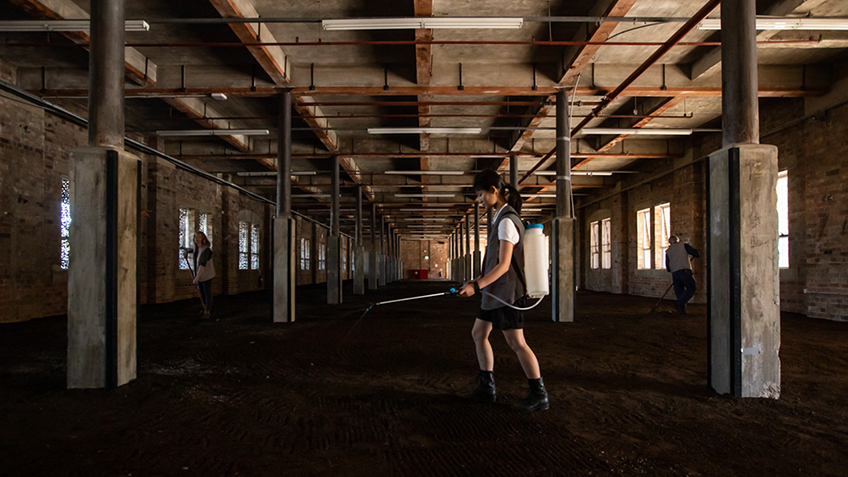Kaldor Public Art Projects and Carriageworks Unveil Project 34: Absorption by Asad Raza | Media Release 1 May 2019
Kaldor Public Art Projects and Carriageworks today unveiled Kaldor Public Art Project 34:Absorption by Asad Raza. Absorption is presented free to the public from 3 to 19 May 2019 at the Clothing Store, Carriageworks.Itrepresents the first exhibition by the New York-based artist in Australia.
Atthe heart of the project is a set of metabolic processesand experiments. A group of “cultivators” continually mix materials sourced from the region, including sand, silt, clay, phosphates, lime, spent grain, cuttlebone, legumes, coffee and green waste to createa new soil mixtureor neosoil. Testing and monitoring its composition as it changes, the cultivators oversee almost 300 tonnesof material, which fills the ground-floor rooms of the Clothing Store. The project functions as a depot for the arrival, combination, and dispersion of this neosoil, which visitors are invitedto take home for their own projects.
Within the world created by Absorption, Raza has also invited other artists to use the installation for their own purposes. Daniel Boyd’s work creates a porous light throughout, whileAgatha Gothe-Snape’s wearable pieces for the cultivators weave relations.Khaled Sabsabihas buried a gridof turf underneath the soil, meditating on the hidden reality beneath the everyday. Jana Hawkins-Andersen’s clay works are broken up to enrich the soil, and Megan Alice Clune’s sound piece reacts to its changing state. Dean Cross’s work introduces a kilogram of earth from 1000km away, and Brian Fuata’sperformative inhabitation ‘haunts’ the space.
Developed in collaboration with a team of scientists at the University of Sydney Institute of Agriculture led by soil scientist Alex McBratney, Raza’s project draws together the approaches and ontologies of art and science. The project aims to bring the biological substrate of life into the foreground, as a living mesh of organic, mineral, and opaque aspects. In Absorption, these elements combine in an artistic world that is in dialogue with the processes of decay and new growth.
Absorptionfeatures a public program series of choreographic, musical, and pedagogical interventions. This includes a pop concert by Chun Yin Rainbow Chan; a new choreographic piece by Ivey Wawnin collaboration with Ivan Cheng, Daniel Jenatsch, Eugene Choi, and TareeSansbury; an event hosted by KandosSchool of Cultural Adaptation; and a reading hosted by feminist reading group Composting.
Kaldor Public Art Projects Director John Kaldor AO said: “I’m delighted that we are doing a project with Asad Raza, whose work very much reflects the spirit of our time. Raza shows us that art, enlisting the help of science, can draw our attention to environmental concerns. Raza’s collaboration with Australian artists is an exciting completion of the project.”
Carriageworks Chair Sam Mostyn said: “This is the second time Carriageworks and Kaldor Public Art Projects have partnered on a major presentation for Sydney audiences, and we are thrilled to be working on this occasion with Asad Raza. Raza’s dynamic and collaborative project extends across our community of visitors and engages a number of our current studio artists.”
Public Programs
Common Ground Asad Raza interviews Professor Alex McBratney 3 MAY FRIDAY 6PM
Composting #32 Substrate Feminist Reading Group 7 MAY TUESDAY 6PM
Surfacingby Ivey Wawn Performance by Chun Yin Rainbow Chan 9 MAY THURSDAY 7PM & 8PM
An artist, a farmer and a scientist walk into a bar… Presented by Kandos School for Cultural Adaptation 18 MAY SATURDAY 6PM
Soil Take Home 19 MAY SUNDAY 10AM –6PM
About Asad Raza
Born in 1974 in Buffalo, USA and of Pakistani background, Raza works with experiences, human and non-human beings, and objects. He conceives of exhibitions as metabolic entities, zones of activity in which he constructs dialogue and scenarios between visitors and participants.
Past works include Untitled (plot for dialogue), for which Raza installed a tennis-like game in a deconsecrated church in Milan. Root sequence. Mother tongue, first shown at the 2017 Whitney Biennial, is a forest of twenty-six living trees with human caretakers in the museum. For home show, which took place at his apartment in New York, Raza asked friends, family and artists to intervene in his own life.
For any media enquiries please contact Sasha Haughan at sasha@articulatepr.com.au
